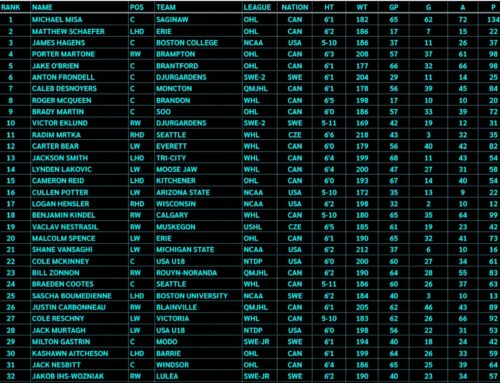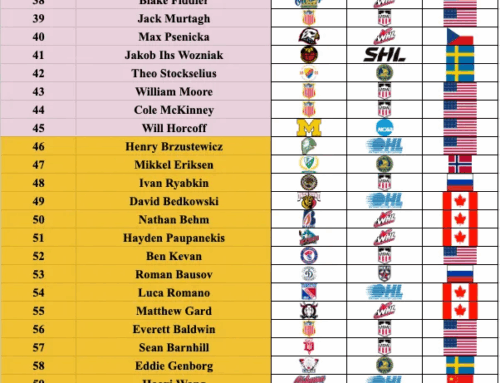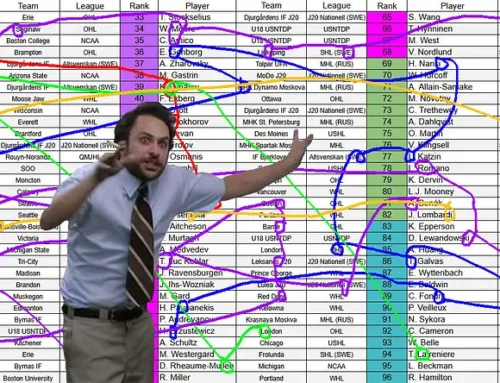DP Draft Reports: Logan Cooley, Kevin Korchinski, Calle Odelius, Jagger Firkus, Mattias Hävelid
Nick Richard
2022-01-28
Powered by InStat Hockey
![]()
Welcome to another edition of DP Draft Reports! This week, the team dives into the tape on Logan Cooley, Kevin Korchinski, Calle Odelius, Jagger Firkus, and Mattias Hävelid.
Cooley is a center for the USNTDP U18 team who has been one of the biggest risers in the 2022 draft class through the first half of the season. He has been a force for the U18s this season, currently leading the team in points per game while displaying a strong two-way game.
Korchinski is a left-handed blueliner with good size who plays for Seattle in the Western Hockey League. He is enjoying a strong season, trailing only Denton Mateychuk in scoring among draft-eligible WHL defencemen, and has started to garner buzz as a potential late first-round pick in July.
Odelius, a puck-moving defenceman out of Sweden, has been one of the top blueliners in the J20 Nationell this season. His solid play has earned him a taste of SHL action and though he has yet to grab hold of a prominent role with Djurgårdens’ main squad, the fact that he has become a viable option at just 17 years of age speaks to his potential.
Firkus hasn’t received the same kind of draft buzz as his Moose Jaw teammate Denton Mateychuk, but his play thus far has certainly warranted more attention than he is getting. He currently leads the Warriors in scoring and sits just behind projected top-five pick Matthew Savoie for second in scoring among WHL draft-eligibles.
Hävelid is a mobile, right-handed defender who has split time between the J20 Nationell and SHL for Linköping this season. He has been fairly productive at the J20 level, as well as for Sweden’s U18 national team, but the points have yet to come as he gets acclimated to SHL competition.
On to the game reports.
Logan Cooley | C | USNTDP U18 vs. Muskegon (USHL) | 2021-10-9
2 G, 2 A, 7 SOG, 14:59 TOI
Nick Richard: Cooley was simply dominant in this game, looking too good for USHL competition. He was the U18’s main driver all night and picked up four points in less than 15 minutes of ice time. His skating ability led to a number of high-danger chances and the way he was able to quickly transition from skating east-west to going north with the puck on his stick caused problems for Muskegon all game long.
Cooley was an electrifying presence right from his first shift of the game, taking a difficult seam pass on the weak side and getting a good shot off after a quick backhand to forehand move. He had another almost identical chance moments later as he took a pass standing still in the neutral zone and quickly accelerated to blow by the defender wide on his off-wing. Cooley got on the board shortly thereafter, making a great play to strip the puck off the defender as he was trying to exit the zone, and quickly cutting back towards the net to beat the goaltender with a quick release. He helped to extend the U18’s lead shortly afterward, controlling the puck around the outside of the offensive zone with speed before firing a hard cross-ice pass to the far point. He followed up the play, corralled a bouncing puck in the high slot, and made an elite move to dart through two defenders and find Rutger McGroarty streaking to the net with a slick backhand feed.
The U18 powerplay ran through Cooley on the right half wall and he proved dangerous as both a passer and a shooter. His quick reads led to efficient puck distribution and he moved well off the puck to find lanes to get his hard one-timer off. His third point of the night came off one such play as he unleashed a heavy one-timer that the opposing netminder was unable to handle and Cruz Lucius was there to bang in the rebound.
Cooley’s defensive play was almost as impressive as he displayed his strong off-puck play all game long. He was always well positioned as an outlet down low and was able to either move the puck to a teammate or skate it up ice himself. He showed an ability to adjust to quick change situations and made a strong play to cut off an attacking forward in the high slot after a turnover by his defenceman. He also took smart routes on the backcheck and showed good instincts to pick up the back door trailer and intercept a pass before using his body to win a battle in the corner and move the puck out of trouble. As play went the other way, Cooley drove wide and stopped up at the far post, and ended up controlling a loose puck before spinning around and firing home a backhander for his second goal of the game.
Cooley’s intelligence, puck skills, and elite skating ability were all on full display in this game. He was able to consistently create separation with the puck on his stick, almost effortlessly, and was nearly impossible for the Muskegon defenders to handle. His entire body was working in concert as he utilized his slick hands, quick feet, and outstanding body control to elude defenders and execute skilled plays under pressure. Performances like this one are why Cooley is likely to be one of the first players off the board on draft day.
Follow @_NickRichard on Twitter
Kevin Korchinski | LD | Seattle vs. Portland (WHL) | 2022-01-14
0 G, 2 A, 5 SOG, 26:22 TOI
Zack Szweras: Korchinski showed strong mobility and aggression in a game where he logged heavy minutes against Portland. In this game, he liked to play with open space in the offensive zone. However, at times neither he nor his defense partner, Blue Jackets prospect Samuel Knazko, were covering a potential breakout which led to a couple breakaways for Portland.
Korchinkski’s vision and passing ability were on full display as he finished with two assists, both on the power play, with the first coming on a 5-on-3 advantage. Seattle likes to use Korchinski as the facilitator at the top because he has shown good vision and patience with the puck, finding the open man to advance play. His offensive game has been on display mainly on the power play and he displays the poise to execute under pressure. Korchinski’s vision is something I keep coming back to – he consistently keeps his head up and surveys the defense for open opportunities. There were a ton of powerplays for Seattle in this game, and each one featured Korchinski playing the role of the quarterback well. He mixed up his passes with decent wrist shots on net when looking for a tip or a rebound.
His vision has also helped him in his transition game. At the start of a shift, Korchinski had the puck come to him right as he stepped on the ice, scanned the ice, and found the open lane to get the puck to his teammate for a zone entry. On another neutral zone rush from Portland, the puck ended up on Korchinski’s stick in his own end and he sent a laser beam pass through the neutral zone to his teammate, which set up a 3-on-2 fast break. When pinned in the defensive end, Korchinski tried making the easy dump pass for a breakout and it was blocked, he got the puck back, looked up, found a teammate in the middle of the ice, and made the outlet pass which started the transition.
The biggest flaw I keep noticing in Korchinski’s game is his overaggressiveness. Playing with a strong defender like Knazko has likely allowed him to experiment with playing more aggressively, but his aggression in the defensive end came back to hurt him many times in this game. For example, Portland was entering the Seattle end and Korchinski was pressuring the puck carrier at the blue line which took him out of position and saw him playing the winger’s role in his own end. This is another problem with being overly aggressive and failing. The puck was coming in on the right side, Korchinski went to pressure and tried to block passing lanes rather than go after the puck. The attacker made a quick cross-ice feed and the puck was shot on net.
Even in transition, Korchinski made a bad read on an aggressive play. He was pinching up to the red line when the opposition was formulating a breakout, the puck went to the attacker Korchinski was shadowing, the opposition made a quick pass, and it created a wide-open lane for an opponent to grab the puck and get a beautiful shot on net, which went in.
When Korchinski is not pressuring defenders at the wrong point, he makes some decent defensive plays. He uses his stick to close space defensively before attacking with the body to strip the puck. On one of Seattle’s power plays, Portland intercepted the puck to start a 2-on-0 breakaway when Korchinski turned on the jets and broke up the pass between the two opposing players to turn the play around.
Playing aggressively in bursts can be an advantage for certain players and certain teams, but the overaggression ultimately leaves Seattle in poor situations and has hurt the team more often than it has helped them. If he can learn when the appropriate time to be aggressive is and when to play a more reserved and calculated game, Korchinski can slot in as a mobile, puck-moving defender at the NHL level.
Follow @Zack_Szweras on Twitter
Calle Odelius | LD | Djurgårdens J20 vs. Skellefteå J20 (J20 Nationell) | 2021-11-20
0 G, 0 A, 1 SOG, 19:26 TOI
Eetu Siltanen: Odelius was one of his team’s leading defenders in this game against Skellefteå. He had a solid game, even though it wasn’t the strongest one I’ve seen from him. He showed excellent puck-moving, good puck skills, and smooth skating, but wasn’t really able to contribute much offensively. He finished with a minus-1-rating; he lost a puck battle and allowed the opponent to throw the puck to the net, which resulted in a goal. He played the point on his team’s primary powerplay unit but was unable to generate much in this one.
Though he didn’t generate much offensively, Odelius was excellent on breakouts. He gave really precise passes and I only counted one misconnected breakout pass, which eventually found his teammate as well. Under pressure, he used his mobility and puck skills to get himself space to move the puck up ice. He also read the game well and made smart decisions when distributing the puck to his teammates. There was one play where Odelius pulled the forechecker towards him, creating more space for his teammate to get open before dishing the puck.
Odelius also showed the ability to carry the puck by himself when it was necessary and was able to control the offensive blue line well, despite being held off the scoresheet. He made some strong defensive plays in this one as well but needs to be way more consistent in his own end. Off the rush, he defended well, maintaining good gaps in defensive transition but in the defensive zone, he had problems from time to time as he wasn’t able to utilize his mobility as much defending in-zone. He has average size and plays an adequate physical game but definitely needs to continue to bulk up, as he wasn’t overpowering by any means, even at the J20 level.
Follow @siltaneneetu on Twitter
Jagger Firkus | RW | Moose Jaw vs. Edmonton (WHL) | 2022-1-25
1G, 3A, 3 SOG, 19:27 TOI
Jameson Ewasiuk: The Moose Jaw Warriors have been rolling as of late and it’s no surprise that their improved play coincides with Firkus finding another level and more consistency in his game. Playing on the Warriors’ top line with Ryder Korczak and Brayden Yager, the trio was all over the Oil Kings in this contest.
Firkus was noticeable early and often, showcasing his quickness in transition and willingness to put pressure on defenders with his speed and skill. His passing was on full display as he picked apart the offensive zone with outstanding tape-to-tape deliveries at any given moment. His ability to react under pressure and make split-second cuts or passes was impressive, to say the least. While he is an excellent playmaker at the WHL level, he may have to make some adjustments at the pro level as I don’t think he will be able to make such effortless passes as he climbs the ranks. On that note, Firkus has proven that he can effectively make adjustments at each level due to his high-level hockey sense. His intelligence especially stood out around the net as he was able to shift or adjust to find open ice for scoring chances and in anticipation plays. His goal-scoring abilities stem from that intelligence rather than being a pure velocity shooter.
Firkus was effective in the defensive zone. His attention to detail and willingness to contribute down low in the zone helped his team limit quality chances against and break up plays. When positioned higher up in his end, the young forward was engaged and aggressive pressuring puck carriers at the point.
While not a physical player, Firkus is competitive and aggressive on the forecheck. He does not hesitate to make contact and has strong puck retrieval abilities. He is undersized and can be knocked around on occasion but as he gets stronger, he will become more sturdy. Added strength should also help him become more explosive in his first step. His overall quickness and top speed are solid but at times his first step does not seem as clean and efficient as it could be.
In the third period, Firkus started to fade a bit and did not seem to have the same level of intensity that he displayed earlier, leaving him prone to a couple more mistakes as well. But with that said, it is important to note that the Warriors went into the third period up 4-1 and then scored two more in the first two minutes of the period before winning the contest 8-1. With such a big lead throughout the final frame, it is not unreasonable to say that he may have taken his foot off the gas a bit.
Firkus is a consensus second-round pick by the majority of draft rankings but if he continues to produce the way he has as of late, he could find himself in first-round contention by the end of the season.
Follow @JamesonEwasiuk on Twitter
Mattias Hävelid | LD | Linköping vs. Timrå (SHL) | 2022-01-24
0 G, 0 A, 1 SOG, 13:57 TOI
Alexa Potack: This game wasn’t a great look at some of the most notable aspects of Hävelid’s game. While he was on the ice, there wasn’t a shift with sustained offensive pressure until the middle of the third period. However, once this happened, Hävelid shone. Although only one of his two shots reached the net, he was circulating the puck, generally staying on the outside or along the blue line.
Typically, Hävelid is dominant with the puck on his stick anywhere on the ice but in this game, it was mostly in the offensive zone. On multiple occasions, Hävelid was struggling to get the puck past Linköping’s blueline because of the opposing forecheck. He would circle, forcing the opposition to chase him as he attempted to exit the zone. When he would try to pass the puck during zone exits, he caused a couple of turnovers. Hävelid usually has no issue finding or creating space on offense so this needs to translate to his defensive skillset more consistently.
The strength that Hävelid relied on most in this match was his skating. Broadly speaking, Hävelid is a fast skater but he has good technical skills when it comes to his edgework and acceleration. His strong footwork is a key skill as he possesses the ability to get back on defense from an offensive rush with ease.
Hävelid understands the level of physicality needed to play men’s hockey and demonstrated that with several calculated but forceful hits during plays along the boards. His off-puck play isn’t perfect, but he was able to use his body to box-out potential passing options on defense. This is a divergence from his two-way nature but a necessary trait as an NHL-hopeful defenceman.
Hävelid is still adjusting his offensively-minded game to the speed, aggression, and talent level of the SHL. Despite Linköping’s J20 team participating in the playoffs, Hävelid has seemingly gotten the call to play with the SHL team. LHC management and coaching appear to be betting on Hävelid adapting to professional hockey with ease, as he is averaging 11:35 TOI through his five professional games this month. Going forward, it is clear that Hävelid has work to do in all aspects of his game to continue to prove himself as a player that is ready to take on the SHL competition.
Follow @alexa_potack on Twitter







